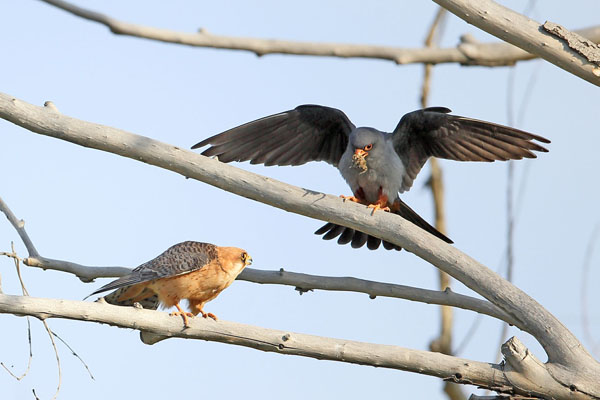Falco vespertinus
IUCN
LCBasic Information
Scientific classification
- name:Falco vespertinus
- Scientific Name:Western red-legged falcon, blue swallow, blue eagle, red-legged kite, red-footed falcon
- Outline:Raptor
- Family:Falconiformes Falconidae Falco
Vital signs
- length:28-33cm
- Weight:130-164g
- lifetime:12-16year
Feature
The wings are long and the undertail coverts are also long.
Distribution and Habitat
In my country, it is found in the northwest of Xinjiang. It has been recorded in Yunnan during the migration season, and stray birds have also been seen in North China. Abroad, it is distributed in Eastern Europe, Central Asia and western Siberia, and winters in southern Africa.
Its habits are similar to those of the red-footed falcon. It likes to gather in small groups and move around in open plains, grasslands, shrubs, low mountain sparse forests, and forest edges below 1,500 meters above sea level. It can also be seen in swamps, rivers, valleys, and farmland in hilly areas.
Appearance
A relatively small falcon. No obvious wing fingers. Slightly larger than the red-footed falcon. With orange-red eye circles, orange-red beak with dark tip, orange-red wax at base of beak, and orange-red tarsus. The male has dark grey head and upper body, dark grey lower body, brown-red underbelly and rump feathers, dark grey tail feathers, similar to the male red-footed falcon, but the underwing coverts are grey-black, very different from the white coverts of the red-footed falcon. The female has brown-yellow chest and abdomen, white throat and cheeks, black eye stripes and light sideburns, grey-black upper back and wings with scaly spots, sparse black vertical stripes on lower body, black horizontal stripes on tail feathers, and the brown-yellow undertail coverts are close to the body color when flying. The body of the immature bird is brown with fine vertical stripes, and the orange-red wax and foot color are not obvious.
Details
The Western Red-footed Falcon is a summer migratory bird in my country. It migrates in spring in early April to late May, and leaves in autumn in October-November. It often moves in pairs and small groups. It flies fast, can flap its wings, hover and glide in the air, and often perches on telephone wires or poles when resting.
The Western Red-footed Falcon is often noisy, especially when they move in groups or gather together at night before going to sleep. Their most common call is the high-pitched "kiou kiou kiou" of the male, and the softer and higher-pitched "kwee kwee kwee" of the female. The call is very similar to that of the Eupator Kestrel when flying, but the frequency is slightly lower. It makes faster calls when panicked.

The Western Red-footed Falcon is a small bird of prey. It flaps its wings rapidly when flying, occasionally gliding, and can also make a short stop in the air by flapping its wings rapidly. It mainly feeds on locusts, crickets, beetles, crickets, and various beetles. Sometimes it also preys on small vertebrates such as small birds, lizards, frogs, and mice.
The breeding season is from May to July. It usually does not build its own nest, but uses the nests of other birds such as crows and magpies. It also builds its own nest when there is no nest available. Usually nests are built in trees, sometimes in tree holes, rock edges and ground bushes. Each nest usually contains 3-4 eggs, occasionally as many as 5 or 6 and as few as 1-2. The eggs are white, densely covered with reddish brown or rusty red spots, and the size of the eggs is 32-42 mm × 26-31 mm. The male and female parents take turns incubating the eggs, and the female bird usually incubates the eggs at night and at the end of the incubation period. The incubation period is 21-28 days. The chicks are late-maturing, and after hatching, they are covered with white down feathers and weigh only 10-13 grams. When they are just hatched, they are mainly raised by the male bird, and the female bird also participates in the raising activities. After 26-27 days of nesting life, the chicks can leave the nest.








